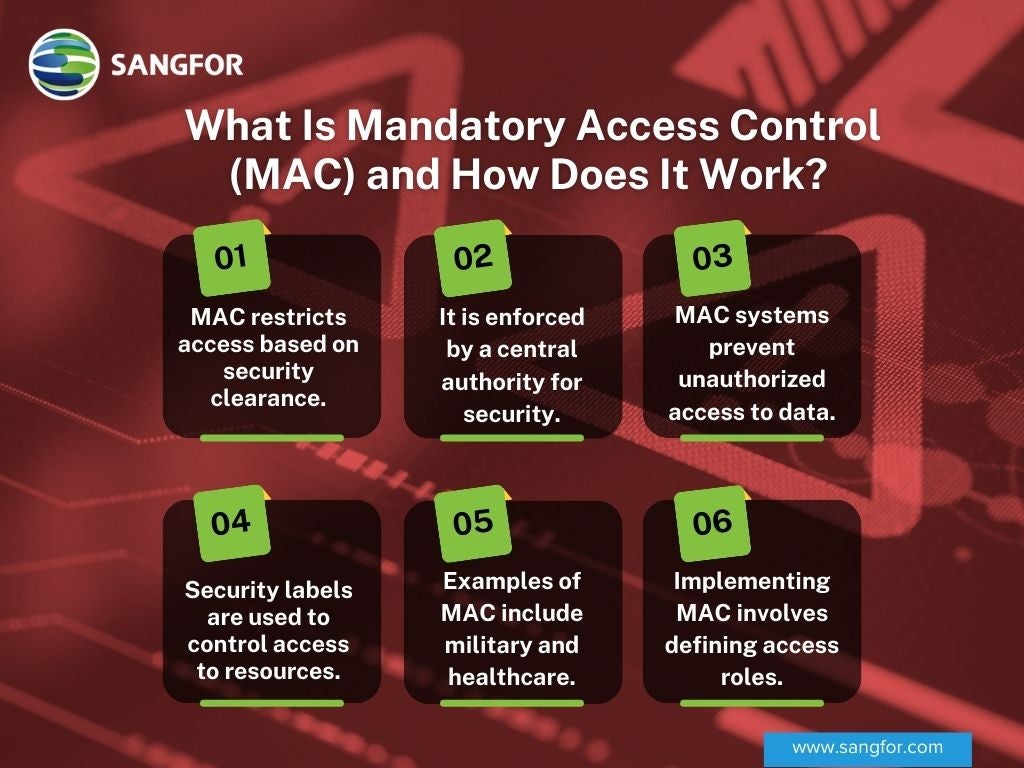Data protection is fundamental in today’s digital world to safeguard critical and sensitive information. For companies and organizations, data protection and security strategies have become imperative to protect trade secrets, customer information, and transactions. There can be extremely harmful consequences for a business, especially financially if data has fallen into the wrong hands. As such, many businesses choose to implement and maintain access control, such as Mandatory Access Control.
Data protection is fundamental in today’s digital world to safeguard critical and sensitive information. For companies and organizations, data protection and security strategies have become imperative to prevent unauthorized access, data breaches, and the exposure of confidential secrets.There can be extremely harmful consequences for a business, especially financially.By doing so, businesses ensure that only authorized personnel can access information, thereby reducing the risk of data breaches and preventing the misuse of sensitive resources.

Mandatory Access Control (MAC) Definition
Mandatory Access Control, or MAC for short, refers to a cybersecurity system that looks to allow or deny access to private and protected information in an organization. Unlike discretionary access control (DAC), where users can control who accesses their data, MAC systems are enforced by a central authority, and access is based on security labels and user roles. For a user to access a resource, they must meet specific criteria such as security clearance or role-based permissions. This system prevents unauthorized access and ensures that data is only accessed by individuals with the proper clearance.
An example of mandatory access control might involve an organization that restricts employees’ access to data based on their roles. Only those with a high-level security clearance can access confidential secret or top secret data. This level of security is critical for protecting sensitive business information, government data, or classified military intelligence.
To carry out MAC, an organization must first put in time and effort to understand the information flow properly and map it out. This includes looking at the users and processes, the resources that are being accessed, and the rules and properties (labels, categories). The system is relatively easy to implement as it generally requires a one-time effort to do, after that, it would only require updates as job roles or organization structures change.
Types of Mandatory Access Control
There are primarily two types of Mandatory Access Control:
- Multilevel security systems: This system consists of a vertical structure of security levels, making it a simple form. Users can only access the information up to their security level clearance, so in the same or lower levels of the vertical structure.
- Multilateral security systems: As in the name, multilateral means not only vertical but also horizontal security systems. This is more complex as the assignment of security clearance is based on segments.
How Does Mandatory Access Control Work?
When a user attempts to access a system, mandatory access control (MAC) systems check the security label assigned to both the user and the resource. If the user's clearance level matches the security label of the resource, access is granted. This level of security ensures that unauthorized access is strictly restricted.
The central authority enforces these rules, which limits how users can interact with data and ensures that only authorized personnel can modify or view confidential data. MAC systems are designed to enforce MAC policies consistently, ensuring that no user can bypass security measures to access data they are not authorized to view.

Why use Mandatory Access Control? The Advantages
There are several reasons why a business might implement a Mandatory Access Control system. You can find the detailed information in this product brochure. Here are a few key reasons why businesses should implement MAC:
- High-level data protection: By strictly limiting access based on security labels and hierarchical roles, MAC systems ensure that only authorized users can access sensitive data, significantly reducing the risk of data breaches. As a mandatory system, businesses can rest assured that confidential and sensitive data is well protected with little room for any leaks. MAC is one of the most secure access systems as it’s carefully planned, checked, and reinforced. Businesses have the peace of mind that only certain, authorized personnel have access to the information needed and no more. Therefore, data cannot be modified without proper authorization.
- Centralized Control: MAC systems provide a centralized framework for managing access control, making it easier for organizations to maintain strict security measures and implement policies that prevent unauthorized access. Any changes will have to go through this singular authority, protecting the data from being tampered with.
- Increased Privacy: Enforcing MAC helps businesses maintain strict control over who can access sensitive resources, minimizing the chances of accidental or intentional data leaks. It can only be updated by the highest level of authorities. Thus, ensuring a certain level of privacy for organizations to keep their data secure.
These are some of the key advantages. However, it’s important to note that in order for your Mandatory Access Control system to stay successful and protect your organization’s data, it must be set up with care and regularly updated. This ensures that the right individuals have access to the right information at all times.
Examples of Mandatory Access Control
MAC systems are commonly used in high-security environments where data sensitivity is paramount. Here are some examples of mandatory access control in action:
- Government and Military: Agencies like the military or government rely on MAC to secure classified information. Mandatory access control (MAC) ensures that only authorized personnel can access top-secret or confidential materials, based on the sensitivity of the data.
- Healthcare and Finance: In sectors like healthcare and finance, MAC systems restrict access to sensitive personal information, such as medical records or financial transactions, to prevent unauthorized access.
However, they can also be used for regular companies who need this type of system to keep their sensitive data controlled, and protected.
Another important note is that due to a MAC system's regular updates and careful setup, it is standard practice and advised to integrate MAC with several other methods of access control to stay best protected.
How to implement Mandatory Access Control?
Implementing Mandatory Access Control (MAC) within an organization involves several key steps. First, companies must assess their data security needs and restrict access based on user roles and security labels. Once the system is set up, access control rules can be configured, enforcing MAC through software tools and security mechanisms.
There are tools available to implement organizational level access control mechanism such as Secure Internet Access by Sangfor. The network administrators can easily configure and implement rules and privileges for each type of user within an organization, ensuring access control lists (ACLs) are properly set up and enforced.
You may check the video below to learn more about Sangfor IAG - Secure Internet Access:
Conclusion
In today’s digital landscape, where data breaches are a constant threat, Mandatory Access Control (MAC) offers a reliable solution to restrict access to sensitive data and prevent unauthorized access. By implementing MAC systems, organizations can protect confidential information and ensure that only those with proper clearance can access critical resources.
To learn more about how you can implement a MAC system in your organization, or strengthen your cybersecurity strategy further with other access control methods, contact our team and we will get in touch shortly.
Frequently Asked Questions
Mandatory Access Control (MAC) is a security model in which access to data is restricted based on the user’s clearance level and predefined security policies. Unlike Discretionary Access Control (DAC), where the data owner has control over access, MAC enforces strict rules based on the sensitivity of the data and the user’s role in the organization.
MAC works by assigning security labels to both users and resources. When a user attempts to access a resource, the system checks whether the user’s security level matches the resource’s security label. If the levels are compatible, access is granted; otherwise, it is denied. This restricts access to sensitive information and ensures that only authorized users can view or modify it.
Mandatory Access Control is important because it enforces strict security measures that prevent unauthorized access to sensitive data. By centrally controlling access through security labels and access control lists, organizations can ensure that their most confidential information is only available to those with the proper clearance, reducing the risk of data breaches.
MAC is widely used in environments where data sensitivity is critical. Examples include:
- Military and Government: Protecting classified information by controlling access based on security clearance.
- Healthcare: Restricting access to patient records and other sensitive medical data to authorized medical personnel.
- Finance: Protecting financial transactions and account information from unauthorized access.
Unlike Discretionary Access Control (DAC), where users have the ability to grant or revoke access to resources, Mandatory Access Control is enforced by a central authority and is not subject to user discretion. MAC is a more secure model for protecting highly sensitive information, as it restricts access based on security labels and job roles, ensuring only authorized users can access specific data.
To implement Mandatory Access Control in your organization, start by analyzing your data and defining access levels based on the sensitivity of the information. Use tools like Secure Access Secure by Sangfor to configure user roles and security labels for resources. After setting up, make sure to regularly update access controls and monitor for unauthorized attempts to access sensitive data.
Yes, MAC can be integrated with other access control models like Discretionary Access Control (DAC) or Role-Based Access Control (RBAC). While MAC provides the highest level of security for confidential information, combining it with other models can enhance flexibility and usability, especially in less sensitive areas of an organization.





